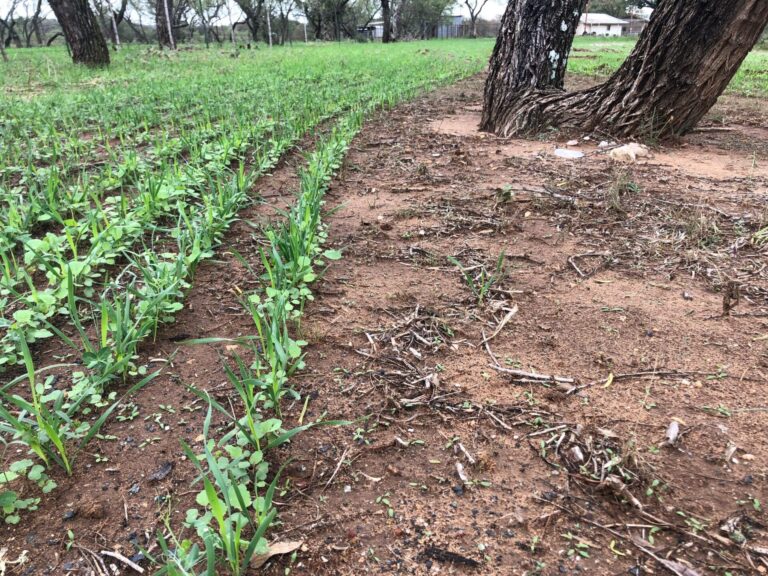Step 0 – Stop grazing the land and let it rest while you do the following steps. You can keep your Agricultural exemption (1-d-1 appraisal) while you do this. Just call your county exemption agent and let them know what your up to. They will grant you a 1 year or more rest period. If selling the herd is not a good option, you can pen them up on a smaller sacrifice zone and feed them hay until you’ve gotten through the process. This can be hard, but it is necessary if you want to stop the decline of your pastures. If you’re able to manage them closely, this process could be done with animals in rotational grazing. Generally, it will be more challenging and labor intensive to get all of the timing windows right. It will require seeding after each move instead of doing it all at once.
Step 1 – Keyline Plow – See this article for more info on what the heck this even is:
Here’s a short video showing some of the results of keyline plowing in one of our projects in Fredericksburg, Texas.

Step 2 – Apply organic soil amendments based off of a soil test. Typically we focus on minerals here not NPK (nitrogen, phosphorus, and potassium).
We’ve got multiple articles going into the art and science of soil amendment on our website. Here’s a good general overview to get started with. You can go deeper down that rabbit hole if this peaks your interests.
https://www.symbiosistx.com/organic-soil-amendment/
Step 3 – Cover crop and native seed application. We’ve found that native seed tends to take a while to come up. Native seeds are more expensive than cover crops. Right now we’re doing a 80-90 % cover crop mix with 20-10% native seeds. This gives you the initial cover you need and invests in the long-term perennial biodiversity we’re seeking in one move. We like to use a no-till seed drill where we can. In certain contexts, it makes more sense to do a hand broadcast. For best results, cover with organic straw or a thin coat of hardwood mulch. 1/4 inch of coverage is all you need to help the seeds germinate.
You can check out a little social media content we made on this here:
https://www.instagram.com/p/Czq5IZ4OYFa/
Step 4 – Bio-Fertilizer/ Compost Tea spray the cover crop and soil. We’ll make some separate videos and articles going into this but for now you can think of this as taking the goodness of compost, making it into a liquid form and spraying it all over the young cover crops and the soil to jump start the microbiology. There’s a lot still to be learned about this field but what we know for sure is that soils with healthy, diverse microbe communities grow plants and cycle nutrients much better than those that have been sterilized through mismanagement.
Here’s a really short, simple, proven way to make a bio-fertilizer using one product:
https://www.symbiosistx.com/the-power-of-em1/

Step 5 – Let it go to seed. Depending on the weather and the seeds you’ve chosen, you may need to let this grow for 2-3 months before letting animals graze on it so that it can go to seed and naturalize. Your putting money in the seed bank, creating a seed store of cover crops to keep helping you build soil next season.
Step 6 – Seed again! Typically we do two rounds of cover crop seeding. One for the cool season mix in Fall and one for the warm season mix in Spring. Once you’ve gotten these two mixes to go to seed, you have a seed bank and you can get volunteers when the weather is right for them to germinate.
Step 7 – Bio-fertilizer/ compost tea spray again! You can do this every quarter if time and resources allow.
Step 8 – Implement rotational grazing. Set stock grazing will ALWAYS lead to a loss of biodiversity. The animals eat their favorite plants until they decline in the landscape. Your stocking rates will go down as your cost of inputs goes up and your soil and the plants in your pastures suffer. The only way that we know of to keep animals on a property and build the soil without constant costly inputs is to implement rotational grazing. In rotational grazing you move the animals into a new paddock as often as needed to give them fresh ground and allow the previous paddock to rest and re-grow. Clearly this is a big topic and we’re not going to cover all the ins and outs here but if this interests you, check back soon for more!
Much of our natural resource wealth is in decline in Texas. This is partly due to set stock grazing for agriculture tax exemption. If we don’t invest in bringing our pastures back to life. Helping them back to their natural state of building healthy soil that supports more biodiversity. We will continue to move towards a more brittle, desert ecosystem instead of the tall grass savannahs that once ranged far and wide across the state.
If you want help figuring this out on your land and you are within 2 hours of Austin, Texas, you can get in touch with us here:



